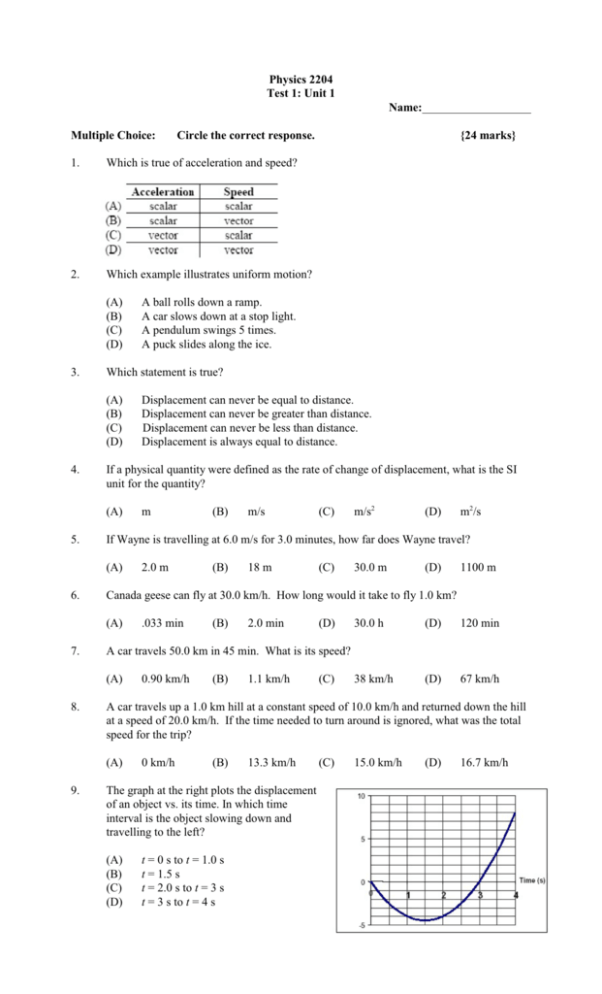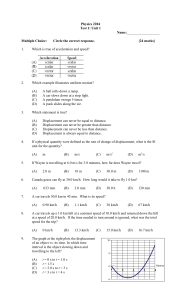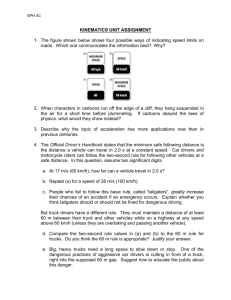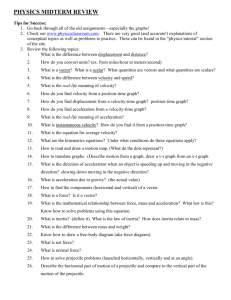Physics 2204 Test 1: Unit 1 Name: Multiple Choice: Circle the
advertisement

Physics 2204
Test 1: Unit 1
Name:
Multiple Choice:
Circle the correct response.
1.
Which is true of acceleration and speed?
2.
Which example illustrates uniform motion?
(A)
(B)
(C)
(D)
3.
(C)
m/s2
(D)
m2/s
2.0 m
(B)
18 m
(C)
30.0 m
(D)
1100 m
.033 min
(B)
2.0 min
(D)
30.0 h
(D)
120 min
0.90 km/h
(B)
1.1 km/h
(C)
38 km/h
(D)
67 km/h
A car travels up a 1.0 km hill at a constant speed of 10.0 km/h and returned down the hill
at a speed of 20.0 km/h. If the time needed to turn around is ignored, what was the total
speed for the trip?
(A)
9.
m/s
A car travels 50.0 km in 45 min. What is its speed?
(A)
8.
(B)
Canada geese can fly at 30.0 km/h. How long would it take to fly 1.0 km?
(A)
7.
m
If Wayne is travelling at 6.0 m/s for 3.0 minutes, how far does Wayne travel?
(A)
6.
Displacement can never be equal to distance.
Displacement can never be greater than distance.
Displacement can never be less than distance.
Displacement is always equal to distance.
If a physical quantity were defined as the rate of change of displacement, what is the SI
unit for the quantity?
(A)
5.
A ball rolls down a ramp.
A car slows down at a stop light.
A pendulum swings 5 times.
A puck slides along the ice.
Which statement is true?
(A)
(B)
(C)
(D)
4.
{24 marks}
0 km/h
(B)
13.3 km/h
The graph at the right plots the displacement
of an object vs. its time. In which time
interval is the object slowing down and
travelling to the left?
(A)
(B)
(C)
(D)
t = 0 s to t = 1.0 s
t = 1.5 s
t = 2.0 s to t = 3 s
t = 3 s to t = 4 s
(C)
15.0 km/h
(D)
16.7 km/h
10.
The velocity-time graph for an object travelling in a straight line is given. Which graph
shows the correct position-time graph for the object's motion?
11.
Examine the graph at the right. What is the acceleration at
t = 3.0 s?
(A)
(B)
(C)
(D)
12.
3.3 m/s2
6.7 m/s2
10 m/s2
11.7 m/s2
Examine the graph shown at the right.
What is the net displacement at
t = 12 s?
(A)
(B)
(C)
(D)
0m
320 m
350 m
380 m
13.
If we assume that motion to the right is
positive, then which of the following
statements describes the motion of the
object depicted in the graph from t = 10 s
to t = 12 s?
(A)
(B)
(C)
(D)
14.
Which of the following statements concerning motion graphs is correct?
(A)
(B)
(C)
(D)
15.
The area under a velocity-time graph gives instantaneous acceleration.
The area under a velocity-time graph gives displacement.
The area under a position-time graph gives velocity.
The slope of a velocity-time graph gives displacement.
Consider the following velocity-time graph and select the statement that is true.
(A)
(B)
(C)
(D)
16.
moving to the left and slowing
down
moving to the left at speeding up
moving to the right and slowing
down
moving to the right and speeding up
The object travels in one direction and then the other.
The object returns to its original position.
The object is accelerating throughout the entire recorded time.
The object speeds up and later slows down.
The position-time graph pictured below depicts a person, P, running to catch a bus, B,
that has just begun to pull away. Which of the following statements is true?
(A)
(B)
(C)
(D)
The person has no chance of catching the bus.
The person's acceleration is greater than that of the bus.
The person has two opportunities to catch up to the bus.
The speed of the bus is always greater than that of the person.
Long Answer: Answer all questions and show all working. Full marks will not be given
without workings
1.
A car travels 68 km/h [E] for 3.5 h and 78 km/h [W] for 2.0 h and then 45 km/h [E] for
1.5 hours. Find its average speed and average velocity.
{6 marks}
2.
A car travelling at 10.0 m/s passes a stopped truck. Three seconds after the car passes,
the truck accelerates from rest at 5.00 m/s2 until it reaches 15.0 m/s.
(A)
Plot a velocity - time graph for the car and the truck on the grid.
{5 marks}
(B)
When did the car and the truck have the same speed?
{1 mark}
(C)
When did truck catch the car?
{5 marks}
3.
Can an object be accelerating and still be travelling at a constant speed? Explain.
{2 marks}
4.
Draw a position-time graph for a runner who moves at 4.0 m/s for 10 s, then at 1.5 m/s
for 20 s, -2.5 m/s for 10 s, then - 5.0 m/s for 10 s.
{5 marks}
5.
The graph below represent an object’s motion for a 20 s time interval. Positive denotes
eastward.
(A)
Calculate the acceleration of the object at t = 6 s.
(B)
Describe the motion of the object for the time interval t = 8.0 s to t = 16 s.
{2 marks}
{2 marks}









